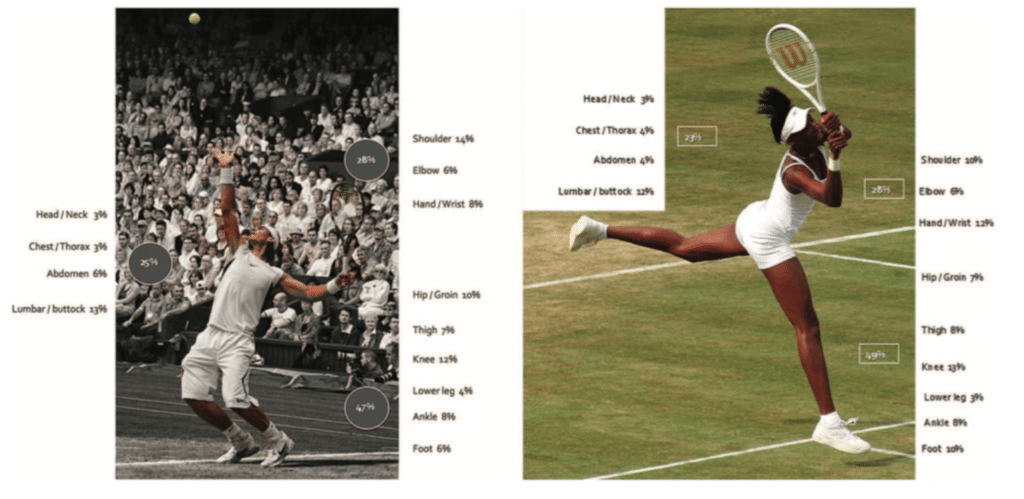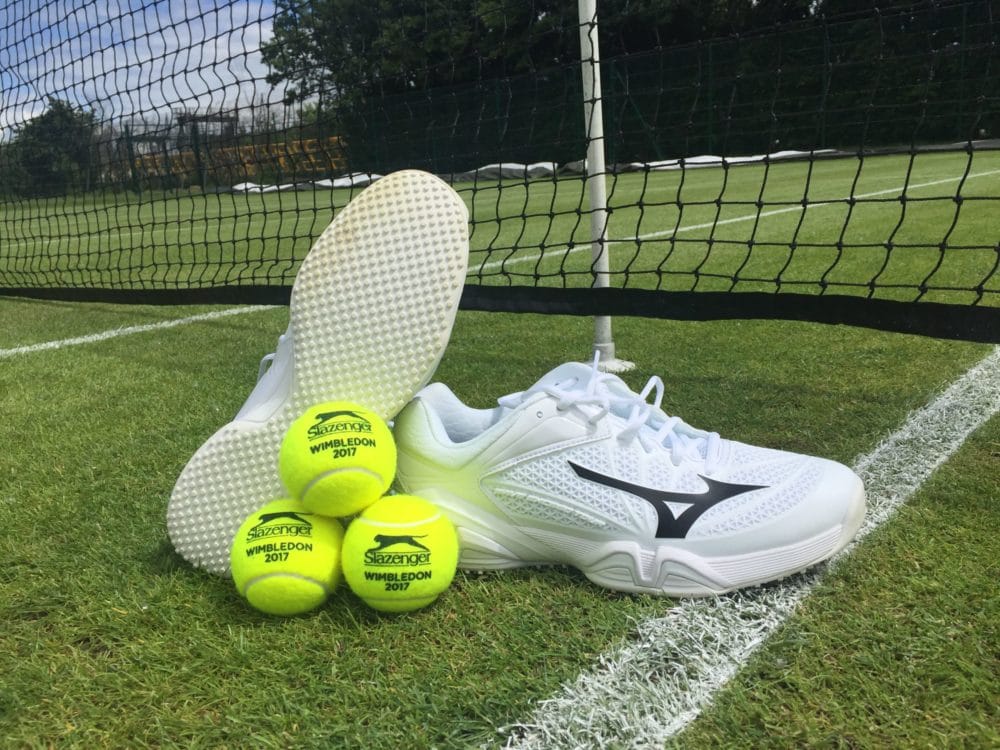The main draw of Wimbledon started earlier today. The third major of the year, in today’s game, is quite unique. Apart from having to wear all white (and indulging in champagne and strawberries during the men’s and women’s finals), this slam is played on the historic grass courts of the All England Club. There was a time when 3 of the 4 majors were played on grass – SW19 is now the only slam played on grass and one of the few events on tour that’s still played on the game’s original surface.
This is by no means a history lesson but rather an opportunity to look at the surface’s uniqueness. More specifically, what does it take to move on this surface? Are injuries more or less prevalent on grass? How does it affect a player’s stance? And what role does footwear play in all this. This article will explore these topics in hope of bringing light to grass court tennis.
Injuries on Grass Court Tennis
At first glance, you would think that perhaps less injuries would occur on grass versus other surfaces. I mean, a grass court is softer, provides cushioning and consequently more force absorption through the joints. However, because of the shoe-surface relationship of grass, and an associated low coefficient of friction, slipping is of primary concern on this surface. On clay for example, not only can a player control sliding but forces are less local and more distributed, resulting in decreased stress on the musculoskeletal system.
But it’s still unclear however, if grass courts are more or less dangerous than other court surfaces. A study by Barnett and Pollard (2010) analyzed all 4 Grand Slams from 1978 to 2005. Overall, Wimbledon had the least amount of incomplete matches (i.e. a player retiring from a match) compared to the other 4 majors. Another study by McCurdie et al (2016) analyzed injury rates at Wimbledon over a 10 year period (2003 to 2012). Similar to previous studies, lower body injuries comprised close to 50% of all injuries, for both males and females (figure 1), during the decade long analysis.

Figure 1. Male & Female Injury Rates at Wimbledon (2003-2012)
Over that time period, acute strains and tears had the highest incidence, followed by chronic tendinitis/bursitis etc. After interviewing a former player and current coach (who has both played and coached at Wimbledon), it was interesting to hear that about 10-15 years ago, Wimbledon altered their maintenance protocol and began keeping the grass at the All England Club slightly longer. This effectively slows the court down and allows for longer rallies. From a movement perspective, this actually makes it more difficult at the beginning of the tournament as players are less able to grip the ground. This partially explains why we see so many slips and falls in in the early rounds at Wimbledon. Although we cannot assume that this is the exact cause of increases strains and tears at Wimbledon, it does seems like a reasonable explanation.
How to Attenuate Slippage and Improve Movement on Grass Courts
“Forget about playing on this surface without the proper footwear – you’ll be sliding around as if you’re on ice”.
This is another interesting comment expressed by my interviewee about grass court tennis. The footwear on grass is different. A grass court shoe has ‘dimples’ or ‘pimps’ – little studs that improve traction and grippage. However, Wimbledon regulates the length of these dimples in an attempt to keep the grass courts in pristine condition. Could you imagine players using shoes that resembled soccer cleats? Yes it would improve traction but after one match the court, as my interviewee exclaimed, “would be absolutely destroyed”.
This may be another reason players slip early on at Wimby, the dimples just aren’t long enough to allow for proper traction. Later in the tournament, as the grass wears down and players are more or less moving on dirt (the grass, especially at the baseline in today’s game, gets worn down completely), the dynamics of friction change and shoe dimples dig into the earth, allowing for better traction. The coach that I interviewed further added that players would prefer longer dimples, but that the organizers at Wimbledon won’t allow it – do court conditions outweigh player safety? I’ll let you decide.
A Closer Look at Grass Court Shoes
Tennis requires movement in a variety of directions – you run forward, backwards, laterally. Not only that, you jump, land, push-off, rotate the foot…you even slide (and not just on clay courts – players slide on pretty much all surfaces these days, including grass). According to researchers from University of Calgary, court shoes require lateral stability, cushioning and traction control. Out of the 3, traction has been seen to be most influential when looking at sport related injuries to tennis in the lower-body. But we’ll get into that shortly.
Lateral Shoe Stability
You wouldn’t think it, but ankle injuries are the most common amongst tennis players (Ellenbecker et al 2007) and lower-body injuries in total, make up just over 50% of all injuries in tennis. Lateral movements that involve excessive supination (i.e. inversion) of the foot during changes of direction, seem to be the main culprit. To prevent rolling your ankle, the tissues that make up the structure must have the capacity to handle inversion loads. While a shoe can help, it’s still necessary to have strength, mobility and joint stiffness at the ankle, mitigating the risks involved in ankle sprains.
Tractions
As we saw earlier, other common injuries in tennis, specifically on grass, are hip and groin strains/pulls. Wearing a grass court shoe with ‘dimples’ is an absolute must, as this provides some traction to prevent excessive sliding/slippage on lawn tennis. Two factors contribute to traction, translational traction and rotational traction. High translational traction essentially means that when decelerating to the ball, a player has less chance of ‘translating’ or moving further along the line of action. This allows the player to make better, faster changes of direction but could result in higher forces in the local tissues leading to both acute and chronic injuries.
On the other side of the coin, if translational traction is too low, players may slip, causing injury, particularly in the groin region.
When it comes to rotational traction, this shoe factor should be low. The forces that players can exert when planting and changing directions are quite high, if rotational traction is high, it could lead to severe ankle, knee and hip injuries through excessive torsional stress at these joints. According to (Reinschmidt and Nigg 2000), traction is the most important factor when it comes to tennis shoe performance. This is especially true on grass courts where having improper footing may result in slippage (and injury) and/or poor stroke execution. Shoe manufacturers must then attempt to find the optimal range in traction to keep players safe and improve performance while still adhering to the regulations at grass court events like Wimbledon.
Changing Direction on Grass – Strength Matters
The ability to change direction effectively in tennis is a key performance indicator. Furthermore, the dynamics of changing direction on grass differ compared to other surfaces. On grass, the bounce of the ball is lower, the court has less traction and therefore, players must maintain a lower center of mass when hitting, moving and changing direction. A 2015 study (Spiteri et al) investigated the mechanical demands of change of direction in sport. These authors reported that each phase of a directional change has different muscle contraction characteristics and should therefore be trained accordingly.
For instance, when tracking down a tennis shot, a player decelerates (depending on the distance they must cover and speed at which they are moving, deceleration demands may vary). This is called the braking phase and for effective execution of this phase, a player must possess a high level of eccentric strength. Next, a player must set themselves in order to hit a shot with pace, spin, direction and so on. When setting, this would be classified as the planting phase. Planting after deceleration requires a high amount of isometric strength – in other words, a player must be able to have the necessary strength to resist momentum (whether that’s forward, backward or lateral). Finally, when attempting to recover after a tennis shot, a player must re-accelerate. This phase is called the propulsion phase.
While all 3 phases are important, I propose that the most essential for grass court movement success is isometric strength during planting. Why? Spiteri et al found that athletes who had faster changes of direction were better able to maintain a lower body position BECAUSE they had greater isometric leg strength compared to slower athletes. Because of the traction issues that may present themselves on grass – and because of the low ball bounce – players who are better able to ‘stay low’ would theoretically have better movement success. But again, it’s the strength to stay low when momentum is trying to carry you in one direction, while you’re attempting to move in the opposite direction, which is critical. Many top tour players make this look easy – you can see them changing direction efficiently on grass while those that lack the strength in the lower body are seen hitting ‘on the run’ more often. Of course there are other variables at play – including tactics, court position, opponent game style and so on. But all else being equal, stronger athletes (especially with respect to their body weight) will be better capable of moving well on ‘slippery’ grass courts.
Final Comments
All in all, grass court tennis presents unique movement demands. Even Andre Agassi in his book ‘Open’ mentioned that the transition between clay and grass is drastic. He went on to add that for him, a greater emphasis on upper-body strength was key during the clay season (because of the high ball bounce) with a greater transition to lower-body strength on grass. Lastly, if you’re planning to play grass court tennis in the near future, an investment in the proper footwear is critical, both from a performance and injury prevention perspective. And don’t wear grass shoes on any other surface as the dimples will wear out in mere hours. Keep them for lawn tennis only and they’ll last for years to come.
Mattspoint.com is a tennis training resource for coaches & players, including the latest in sport science research & training videos. Coach Matt Kuzdub offers on and off court tennis training to maximize performance & prevent injury.
Follow on Facebook
IF YOU ENJOYED THIS POST, PLEASE SHARE IT ON FACEBOOK AND TWITTER. ESPECIALLY WITH PLAYERS & COACHES. THANKS!

